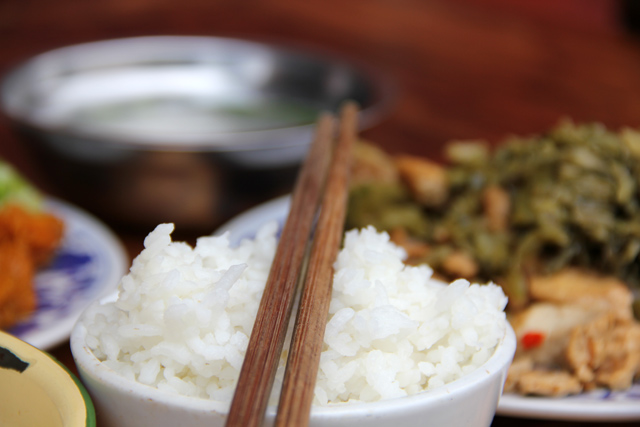Eat Vietnam – how to become a local
Published: 05/11/2012 04:10
How do the Vietnamese enjoy their food? Many of my expat friends often ask this question on their first visit to Vietnam. It’s hard to accurately explain all the regional culinary styles and nuances. But, in brief, common to all Vietnamese cuisine are three main fundamentals: completeness, symmetry and free-n’-easy.
In general, Vietnamese cooks pay great attention to the balance of ingredients in each dish. Yin and Yang, pillars of ancient Asian philosophy, account for the stability of all substances Completeness: In daily meals, the Vietnamese rely on all the 5 senses to tickle the appetite. Almost all common dishes are dressed in vivid colors from the red of chilies, the green of onions and the white of green-pea sprouts to the yellow of egg yolks. For special events, the cooking is decorated or arranged in the shape of animals or flowers. Occasionally diners roll up their food into sheets of rice paper and/or fresh herbs right at the table, thus experiencing the food’s texture minutes before it overwhelms the taste buds. Whether the source is curry, cinnamon, ginger or a multitude of fragrant herbs, let us not forget about every culinary creation’s distinct scent. A very special fragrance is the one emanating from cà cuốngessence. This delicacy, commonly found in Hanoi’s trademark steaming rice rolls, consists of the liquid extracted from an insect known as Tây hồ. Symmetry: In general, Vietnamese cooks pay great attention to the balance of ingredients in each dish. Yin and Yang, pillars of ancient Asian philosophy, account for the stability of all substances. Yin is negative and Yang is positive. The reciprocal neutralization of positive and negative factors is thought of as making food healthier. Fish sauce, ever-present in every Vietnamese meal, is complemented by sugar (sweet), lemon or vinegar (sour), chilies (hot) and other ingredients such as garlic. Saltiness and spiciness are positive while sourness and sweetness are negative. As most meats are positive, adding vegetables, which are considered negative, will ensure balance. Vietnamese cooks are also concerned with the health properties of their dishes.A gourmet‘s lean bowl of Phở might come with a side of fatty-juices. Some sliced ginger in a bowl of rice porridge will help one recover from a cold-induced fever while sliced green onions and coriander will speed up the recovery of someone affected by heat-induced fever. Rice porridge with meat or fish and some kind of spices is always a popular choice for those mending a variety of ailments. Among other dishes served as a medical treatment are steamed black chicken with Chinese herbs and swallow’s nest soup. A Vietnamese saying goes: To win your husband’s love, serve him a bowl of rice porridge with duck broth, thiên lý flower soup and lotus-bean sweet soup”. Also a concern of the experienced Vietnamese cook is the correlation between food and climate. Summer meals are rich in vegetables and fruits while more nutritious meat and fish dishes abound at the gourmet’s table during winter. In the highland regions, ingredients rich in heat (yang) such as garlic, black pepper and ginger are assumed to prevent malaria. Free-n’-easy: All courses are served at the same time and the Vietnamese are free to choose their favorite dish from a varied selection. There is no pressure to try them all and left-overs are acceptable. Especially dishes accompanied by shrimp paste, whose strong smell is not popular among many foreigners, can be avoided by those who are yet to acquire the taste. As guests it is usually good etiquette to leave some food in your bowl to reassure your hosts that they cooked more than enough food for everyone. Some food can be eaten with bare hands and if you are not comfortable with chopsticks your hosts will be happy to provide you with fork and spoon. Chatting at the dinner table is not considered impolite; rather, it makes for a warm, cozy and more relaxed meal. A few glasses of rice wine or beer will further warm up the meal too. Offering or receiving food from each other’s bowls is thought of as a friendly gesture. It also shows the elders that you respect them. So in which ways do you think you will better enjoy your food?
Source:Tuoitrenews |
Provide by Vietnam Travel
Eat Vietnam – how to become a local - | vietnam travel company
You can see more
enews & updates
Sign up to receive breaking news as well as receive other site updates!
- Banh Đa Cua - a traditional Hai Phong specialty
- Exploring Lai Chau cuisine
- Hanoi ranked top 3 cuisine in the world in 2023
- Beautiful resorts for a weekend escape close to Hanoi
- Travel trends in 2023
- In the spring, Moc Chau is covered in plum blossoms.
- The Most Wonderful Destinations In Sapa
- Top 3 Special festivals in Vietnam during Tet holiday - 2023
- 5 tourist hotspots expected to see a spike in visitors during Lunar New Year 2023
- How To Make Kitchen Cleaned
-
vietnam travel
http://www.vietnamtourism.org.vn " Vietnam Tourism: Vietnam Travel Guide, Culture, Travel, Entertainment, Guide, News, and...
-
Vietnam culture, culture travel
http://travel.org.vn " Vietnam culture
-
Vietnam travel, vietnam travel news, vietnam in photos
http://www.nccorp.vn " Vietnam travel, vietnam travel news, vietnam in photos
-
Vietnam tourism
http://www.vietnamtourism.org.vn " The official online information on culture, travel, entertainment, and including facts, maps,...
-
Vietnam Travel and Tourism
http://www.vietnamtourism.org.vn/ " Vietnam Travel, Entertainment, People, Agents, Company, Vietnam Tourism information.
-
Information travel online
http://www.travellive.org "Information travel online













